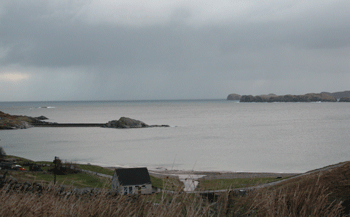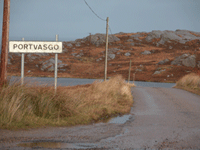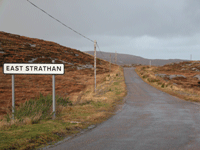
Mackay Country
Dùthaich Mhic Aoidh
An area in North-West Scotland of natural unspoiled beauty, rich in heritage & history
Melness

Crofting townships on the west side of Tongue, small harbours situated at the mouth of the Kyle of Tongue overlooking the Rabbit Islands. A sloop carrying French gold for Prince Charles Edward ran aground here in 1745.
Turn left at the road to Melness just prior to the Kyle of Tongue on the A838 from the esat into a little labyrinth of townships. Melness House, Midtown, Skinnet, Talmine, Strathan, Portvasgo, Midfield around the coast and western head of the Kyle of Tongue. From the junction at the Causeway, a minor road takes you past one of Scotland’s more scenic cemeteries and through the strung-out settlements A visit to Melness comprises of many small old townships and a diverse mixture of dwellings, old, new converted, new looking traditional and modern. Much building work with houses clustered together making a hamlet with a distinct difference.
The community of Melness is a community of small crofting townships, comprising of about 70 households (or about 100 houses), stretching for about five miles around the beautiful Kyle of Tongue. Melness Estate extends to some 10,500 acres of generally poor hill grazings and crofts, sloping from Ben Hutig down to the Kyle of Tongue and the Moine. The estate includes a couple of burns, several beautiful beaches, a sheltered harbour and pier, several lochs, a couple of islands, and extensive peatlands.

The community of Melness has survived mainly as a close-knit core of indigenous crofters, many of whom are descended from the original folk who settled there after being removed from their holdings during the Clearances. They have a close relationship with the land, which they have worked daily for generations, and their community was built stone by stone by their forebears. Melness crofters are very proud of their heritage and extremely proud and supportive of their own folk. They have a keen sense of belonging to Melness and like to maintain their roots there. Indeed, many folk who have left Melness return regularly to visit their relatives and friends and to enjoy the local hospitality, whilst many others retire to their roots in Melness. In short, as one local person rather aptly put it, “You can take a local person out of Melness, but you can’t take Melness out of a local person!”
Particularly in recent years, the local economy in Melness has been characterised by a limited range of small-scale employment opportunities, mainly in public and local services, but also in crofting, forestry, shell fishing, fish farming and estate work. As in most other remote rural communities, there has been a disproportionately high number of retired residents, compared with younger working folk – many younger folk have left to pursue better socio-economic opportunities elsewhere, and many older folk have retired to Melness, attracted by the quiet and natural way of life there.
The Rabbit Islands Bonnie Prince Charles was said to have lost a sailing ship, the “Hazard” on the Rabbit Islands! In 1745, a sailing ship carrying provisions and gold for the Prince ran aground here and the French troops sent to recover them were captured by the Scots! The islands are noted for their fine sub-aqua diving, canoeing and as a picnic spot. The islands are home to more stunningly inviting, if rather inaccessible, white beaches. Just off shore from Talmine itself is the tiny Talmine Island. If you would like a run out to the Rabbit Islands, the best thing to do would be to ask at the Craggan Hotel in Melness, where there is usually local entertainment. The Craggan Hotel often has theme nights, which are very popular, and also impromptu music sessions, who wants to be a Millionaire Nights, and Quiz Nights! The food is popular and locally recommended! “Hamish” the landlord is a mine of stories and local knowledge. Melness Church of Scotland Services are on Sunday at 12.30pm. with the Minister, Rev. J.E. Mackie and visitors are welcome.
The camping and caravan Site at Talmine looks out over the sea. The harbour at Talmine has a slipway suitable for launching small boats but it is very long and very steep. You often see people fishing from the rocks and as the harbour is normally very clean and sandy, it has been known for people to swim there when it is quiet, often using the harbour wall as a launching site when the tide is in! The rocky outcrop that forms the end of the harbour is studded with black and ruby garnets!






MELNESS TONGUE SKERRAY
“Numbers on the school roll show that community decline has not reached a hopeless stage-there are still 30 children at the three-teacher school, although they have to go to Dornoch or Golspie in the south-east of Sutherland for secondary education after reaching the age of twelve.”
Dr. James Coull Scottish Studies, 7, (1963).
The beach is a beautiful sandy beach with a couple of ship-wrecks, one much more modern than the other.
Talmine is one of a string of small hamlets looking northeast across Tongue Bay. It lies a couple of miles north of the main A838 road at the west end of the Kyle of Tongue. Talmine itself consists of two roads running around the back of an east facing bay, one at higher level, the other descending to give access to the beach and the small campsite behind it. Talmine is really all about its beaches and its bay. It also offers superb sea views to the northeast. These extend from the Sutherland coast east towards Bettyhill and include an intriguing collection of small islands in Tongue Bay itself. Largest and most distant of these is Eilean nan Ron, home to 30 people as recently as 1931 but now uninhabited by all but the spirits of the departed residents, by large numbers of seabirds, and by the grey seals who mass here every autumn to pup.
At the far end of Talmine the two roads come together again, before a branch leads down to the pier connecting the mainland with the tiny Eilean Creagach, complete with another lovely little beach. Another road from the far end of the bay leads north to the even smaller settlements of Achinahuagh, Port Vasgo and Lubinvullin. At the end of the road is Port Vasco. This is a natural harbour, set in amongst the wonderfully wild Sutherland landscape. In the 19th century it was once a very busy harbour in the export of high quality stone and slate.
One of the joys of traveling in Mackay Country is that it is still possible to take a turning off a main road and find at the end of it a gem that can still qualify for the title of “lost”. Talmine and Melness are perfect examples.
On the Melness peninsula is Ben Hutig.